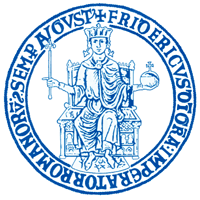University of Naples Federico II
The University of Naples Federico II (Italian: Università degli Studi di Napoli Federico II) is a university in Naples, Italy. Founded in 1224, it is the oldest public non-sectarian university in the world, and is now organized into 26 departments. It was Europe's first university dedicated to training secular administrative staff,[1] and one of the oldest academic institutions in continuous operation. Federico II is the third University in Italy by number of students enrolled, but despite its huge size it is still one of the best universities in Italy and world, being particularly notable for research; in 2015 it was ranked among the top 100 universities in the world by citations per paper.[2]The university is named after its founder Frederick II. In October 2016 the University hosted the first ever Apple IOS Developer Academy and in 2018 the Cisco Digital Transformation Lab.[3]
Università degli Studi di Napoli Federico II | |
 | |
| Motto | Ad Scientiarum Haustum et Seminarium Doctrinarum |
|---|---|
Motto in English | For the inculcation of the sciences and the dissemination of knowledge |
| Type | Public |
| Established | 5 June 1224 |
| Endowment | €473 million |
| Rector | Prof. Gaetano Manfredi |
Administrative staff | 5,517 (2013) |
| Students | 78,324 |
| Undergraduates | 44,700 |
| Postgraduates | 33,600 |
| Location | , Italy |
| Campus | Urban |
| Sports teams | CUS Napoli |
| Affiliations | Campus Europae, UNIMED, PEGASUS |
| Website | www |

History
The University of Naples Federico II was founded by emperor of the Holy Roman Empire Frederick II on 5 June 1224. It is the world's oldest state-supported institution of higher education and research. One of the most famous students was Roman Catholic theologian and philosopher Thomas Aquinas.
Political project of Fredrick II
Fredrick II had specific objectives when he founded the university in Naples: first, to train administrative and skilled bureaucratic professionals for the curia regis (the kingdom's ministries and governing apparatus), as well as preparing lawyers and judges who would help the sovereign to draft laws and administer justice. Second, he wanted to facilitate the cultural development of promising young students and scholars, avoiding any unnecessary and expensive trips abroad: by creating a State University, Emperor Frederick avoided having young students during his reign complete their training at the University of Bologna, which was in a city that was hostile to the imperial power.[4][5][6]
The University of Naples was arguably the first to be formed from scratch by a higher authority, not based upon an already-existing private school. Although its claim to be the first state-sponsored university can be challenged by Palencia (which was founded by the Castilian monarch c.1212), Naples certainly was the first chartered one.[7]
The artificiality of its creation posed great difficulties in attracting students; Thomas Aquinas was one of the few who came in these early years. Those years were further complicated by the long existence, in nearby Salerno, of Europe's most prestigious medical faculty, the Schola Medica Salernitana. The fledgling faculty of medicine at Naples had little hope of competing with it, and in 1231 the right of examination was surrendered to Salerno. The establishment of new faculties of theology and law under papal sponsorship in Rome in 1245 further drained Naples of students, as Rome was a more attractive location. In an effort to revitalize the dwindling university, in 1253, all the remaining schools of the university of Naples moved to Salerno, in the hope of creating a single viable university for the south.[8] But that experiment failed and the university (minus medicine) moved back to Naples in 1258 (in some readings, Naples was "refounded" in 1258 by Manfred Hohenstaufen, as by this time there were hardly any students left). The Angevin reforms after 1266 and the subsequent decline of Salerno gave the University of Naples a new lease on life and put it on a stable, sustainable track.[7]
Academics
The university has 13 faculties:
- Agriculture
- Architecture
- Biotechnology
- Economics
- Engineering
- Law
- Letters and philosophy
- Mathematical, physical and natural sciences
- Medicine and surgery
- Pharmacy
- Political sciences
- Sociology
- Veterinary medicine
Ranking
| University rankings | |
|---|---|
| Global – Overall | |
| ARWU World | 301–400(2020) |
| QS World | 392(2021) |
| THE World | 401–500(2021) |
| USNWR Global | 192(2021) |
Noted people
Notable alumni
Among those who have attended the University of Naples Federico II are Italian presidents Enrico De Nicola, Giovanni Leone and Giorgio Napolitano; Italian political leader Luigi de Magistris; business executive Fabrizio Freda; and philosophers Benedetto Croce and Nicola Abbagnano.
- Samantha Cristoforetti, astronaut
- Saint Thomas Aquinas, philosopher and theologian
- Leonardo Bianchi, physician and politician
- Giordano Bruno, philosopher, Dominican friar, mathematician and astronomer
- Renato Caccioppoli, mathematician
- Antonio Cardarelli, physician and politician
- Ernesto De Martino, historian of religion and folklore scholar
- Francesco De Martino, eminent jurist, intellectual and politician
- Fabrizio de Miranda, structural engineer
- Gaetano Filangieri, jurist and philosopher
- Marta Filizola, computational biophysicist[9]
- Nicola Fusco, mathematician
- Pietro Giannone, historian, philosopher and jurist
- Nunziante Ippolito, physician and anatomist
- Antonio Labriola, philosopher
- Saint Alphonsus Liguori, Doctor of the Catholic Church
- Attilio Micheluzzi, comics author-artist, graduate in architecture
- Giuseppe Mingione, mathematician
- Giuseppe Moscati, Roman Catholic saint, physician, educator, and scientist
- Francesco Saverio Nitti, economist and politician
- Umberto Nobile, aeronautical engineer and Arctic explorer
- Luigi Palmieri, physicist
- Luca Parmitano, astronaut
- Raffaele Piria, chemist
- Roberto Saviano, journalist and novelist
- Vincenzo Tiberio, physician
- Anna Tramontano, computational biologist
- Cinzia Verde, marine biochemistry researcher
- Giambattista Vico, philosopher, historian, and jurist
Presidents of the Italian Republic
Notable professors
- St. Thomas Aquinas, influential philosopher, saint, influential theologian
- Leonardo Bianchi, physician and politician
- Renato Caccioppoli, mathematician
- Antonio Cardarelli, physician and politician
- Domenico Cotugno, physician
- Nicola Fusco, mathematician
- Antonio Genovesi, philosopher and economist
- Giovanni Filippo Ingrassia, physician
- Stefania Filo Speziale, first woman to graduate in architecture in Naples
- Ettore Majorana, physicist
- Macedonio Melloni, physicist
- Giuseppe Mercalli, volcanologist
- Vincenzo Monaldi, physician and physiologist. First Italian Minister of Health
- Francesco Saverio Nitti, economist and politician
- Luigi Palmieri, physicist and meteorologist
- Alessandro Piccolo, Italian chemist and agricultural scientist
- Nino Salvatore, physician
- Giosuè Sangiovanni, zoologist, founder of the Faculty of Natural Sciences
- Filippo Silvestri, entomologist
- Giambattista Vico, philosopher, historian, and jurist
Honoris Causa graduates
See also
References
- Astarita, Tommaso (2013). "Introduction: 'Naples is the whole world'". A Companion to Early Modern Naples. Leiden: Brill. p. 2.
- "University of Naples – Federico II". Top Universities. 16 July 2015. Retrieved 16 July 2019.
- "Polo Universitario di San Giovanni a Teduccio: inaugurato il Cisco Digital Transformation Lab – Primo Piano – Regione Campania". regione.campania.it. Retrieved 16 July 2019.
- Capitani, Ovidio (1981). Storia d'Italia. 4. Turin: UTET. p. 122.
- "Cenni storici (English version)". unina.it. Archived from the original on 14 October 2013. Retrieved 12 October 2013.
- Kamp, Norbert. "Federico II di Svevia". treccani.it. Archived from the original on 12 October 2013. Retrieved 12 October 2013.
- Rashdall, Hastings (1895). The Universities of Europe in the Middle Ages. 2. p. 22ff. ISBN 9780790580487. Archived from the original on 30 April 2017. Retrieved 16 February 2016.
- Briggs, C.A. (1916). History of the Study of Theology. 2. p. 48. Archived from the original on 1 May 2017. Retrieved 16 February 2016.
- "Marta Filizola – The Mount Sinai Hospital". The Mount Sinai Hospital. Archived from the original on 30 January 2016. Retrieved 24 January 2016.
External links
| Wikimedia Commons has media related to University of Naples Federico II. |
- (in Italian) University of Naples Federico II Website
- (in Italian) Girolamo Arnaldi, Studio di Napoli in Enciclopedia Federiciana, Rome, Istituto dell'Enciclopedia Italiana, 2005.